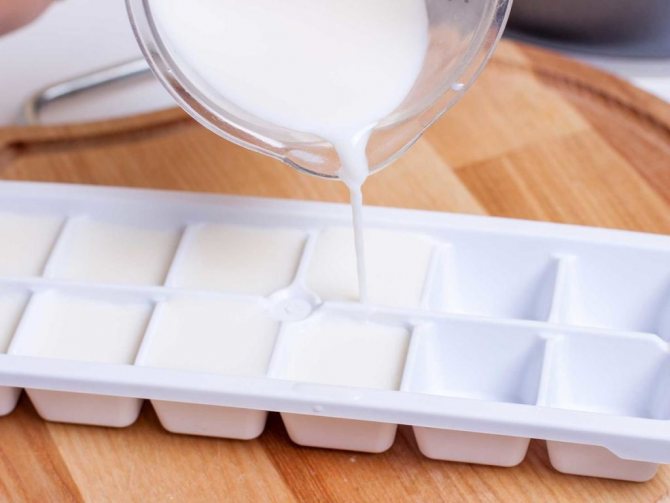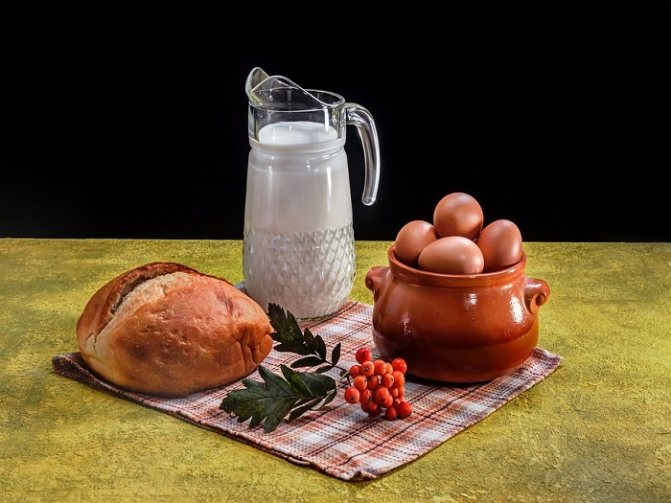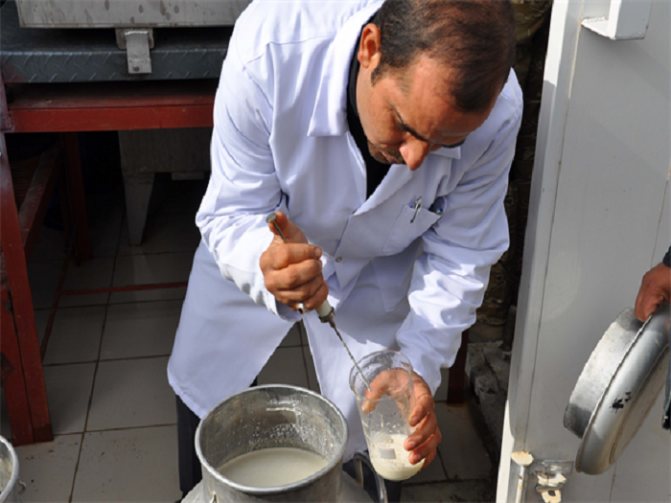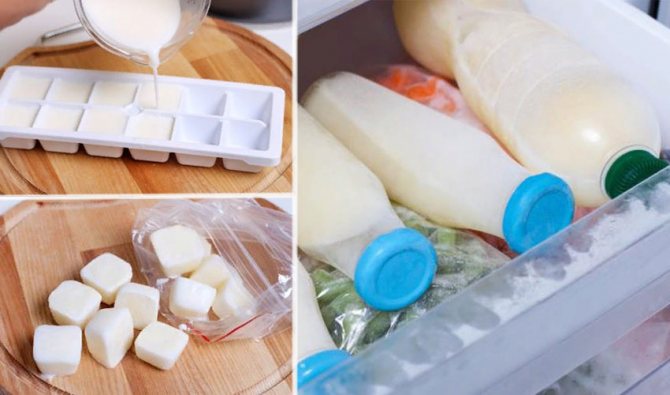Shelf life of milk
First, let's look at how to store homemade milk. Many of us prefer homemade or farm milk to factory milk. Unless pasteurized, raw milk has a limited shelf life. So→
- at a temperature of 6-10 degrees, the shelf life of raw milk is 12 hours,
- at 6-8 degrees up to 18 hours,
- at 6-5 up to 24 hours,
- at 3-4 degrees milk is stored for one and a half days,
- and at 1-2 degrees the milk will remain fresh for up to two days.
1. The shelf life of raw milk can be increased by freezing. In the form of ice, milk has an unlimited shelf life.
2. The shelf life of boiled milk can be up to 3-4 days (and at low temperatures up to two weeks). However, experts do not recommend overusing boiling. Basically, milk is boiled for children to kill pathogens that may be contained in raw milk. But it is worth remembering that boiling reduces the beneficial properties of milk. So, when boiling, part of the protein settles on the walls of the dish, in addition, calcium and phosphorus turn into a slightly soluble form and are poorly absorbed by the body. With prolonged or repeated boiling, milk loses most of its protein and vitamin C.
You should not store boiled milk in daylight; sunlight destroys vitamins C and riboflavin, vitamin B2, which dairy products are rich in. Therefore, it is better to pasteurize milk at home.
How to prolong the freshness of milk
Boiling
Raw homemade milk is the most defenseless.
- The unprocessed product is stored for up to 24 hours at a temperature not lower than 1 °C and not higher than 20 °C.
- At room temperature this period is reduced to 10 hours.
It is advisable to sterilize raw milk to get rid of microorganisms and increase its shelf life. And you must do this if you bought bottled milk for an occasion at the market.
For proper boiling:
- Choose a pan. Glass, aluminum or steel are suitable.
- Checking for freshness. Pour the milk into a tablespoon and bring it to the flame. If it is not fresh, it will curdle immediately.
- We checked everything and made sure the product was fresh. Pour milk into the pan, put it on low heat and keep an eye on it - it will try to “escape”.
- Bring to a boil and turn off. Every minute kills vitamins and “curdles” calcium. It is this that remains like scum at the bottom.
- Then let it cool and pour into a container that has been prepared for storage. The container must be disinfected by dousing it with boiling water.
After boiling, milk will last at room temperature for a day, in the refrigerator - up to 7 days.
To prevent milk from running away, place an inverted saucer or a special milk “guard” - a ribbed circle with a spout - on the bottom of the saucepan.
Freezing
Some people ask: is it possible to freeze milk? Can. This increases shelf life, but loses enzymes and some vitamins. Therefore, it is better to drink what you have just bought, rather than defrosted.
The freezing process is simple:
- Pour the milk into the container you have chosen for freezing. Do not fill to the brim because the product will expand as it freezes.
- It is better to start the process with quick freezing at -22 °C.
That's all. It is better to defrost milk on the bottom shelf of the refrigerator; by evening it will be ready for use. But keep in mind that defrosted food cannot be re-frozen. So all the benefits and taste will be lost.
Frozen milk can be stored until defrosted. But we do not recommend keeping it in this form for more than 2 months.
Note to the hostess
It should be noted that after defrosting, organoleptically (taste, color, consistency) milk no longer resembles the original product.
Shelf life of milk
- The shelf life of milk depends on the method of its processing, storage location and packaging. Fresh milk can be stored in the refrigerator for up to two days, and boiled milk for three days.
- At room temperature, fresh milk can be stored for no more than 10 hours. Boiled milk has a slightly longer shelf life – 18 hours.
- The longest shelf life is for milk stored in a tetra pack. In such packaging, milk does not lose its properties for 6 months.
Baked milk
An original Slavic dish is baked milk. In the old days, such milk was made in a Russian oven in a clay vessel. Baked milk is especially useful for people with weakened bodies and children. This milk contains a high fat content - up to 6% and a high calcium content.
The shelf life of baked milk is not much different from boiled milk. You can make baked milk at home. There are three ways to prepare such milk - in the oven, in a slow cooker and in a thermos. The most important thing is to comply with the basic condition: the milk should be at a temperature of 85 - 95 degrees, for at least one and a half hours. If you add a spoonful of sour cream to the milk, you will get a very tasty and healthy product - fermented baked milk :)
Pasteurized milk
To preserve the nutrients of milk and preserve all vitamins and minerals, pasteurization is used in the industry. Before processing, milk is cleared of large impurities by straining. During the pasteurization process, both pathogenic organisms and lactic acid bacteria in milk are destroyed, which contribute to the souring of milk and its transformation into yogurt. Just like when boiling, milk loses some of its protein, vitamins and minerals, but in much smaller quantities.
The main condition for pasteurization is that the milk must be heated to at least 70 degrees Celsius. At home, milk can be pasteurized by placing it in a water bath, the processing time should be 20-30 minutes. With this method, the greatest amount of nutrients and minerals is preserved. After pasteurization, it is better to quickly cool the milk, then the shelf life of pasteurized milk will increase significantly.
Processing methods
Fresh whole food is healthy and nutritious, but only if it comes from a healthy animal. If there is any doubt about the manufacturer, caution is advised. When purchasing a product in a store, you must read the information on the packaging. Manufacturers guarantee different periods: from several days to six months. What determines such a difference in the performance of one product, only on the processing method.
Many people believe that shelf-stable milk is not real. But now a lot of ways have been found to save a valuable product. It is necessary to make sure that the product does not contain chemicals or strong preservatives that can harm health. Information about the composition, as well as the expiration date, is located on the packaging.
- Raw milk must be boiled and placed in the refrigerator. At room temperature it lasts for less than a day, and in the refrigerator for up to a week.
- Sterilized milk is processed at temperatures above one hundred degrees. There are no beneficial properties left in it, but such a product cannot harm either. The shelf life in sealed packaging is six months.
- Pasteurized milk is heated to 70 degrees, which preserves most of the beneficial properties and eliminates microbes. The product will last in the refrigerator for about five days.
- UHT milk is subjected to a contrasting heating and cooling procedure. It can be stored for six months, but loses all its beneficial qualities.
These processing methods extend the life of the product, which is included in the daily diet. But there are other ways to change the taste and consistency of milk. If there is a large amount of product, you can use one of the storage options.
- Baked milk is boiled at a uniform temperature of 85-90 degrees. During prolonged heat treatment, it becomes thicker and more concentrated. The specific gravity of fat and calcium in the product increases. Shelf life in the refrigerator reaches 10 days.
- Condensed milk is processed at high temperatures and loses its beneficial properties, but greatly benefits in terms of taste. The product can be stored for up to 3 years.
- Powdered milk can be kept at room temperature for up to three years if it is skimmed. It is recommended to keep the whole product for no more than 10 months, as fats give it bitterness.
Each processing method has its own characteristics. Milk, different in taste and consistency, has its admirers and consumers.
Conditions and periods of storage of industrial milk
Sometimes the shelf life of milk according to GOST differs significantly from what is stated by the manufacturer or from what we actually receive. This largely depends on the method of processing, storing and packaging milk. Also, the shelf life depends on the delivery method and storage conditions of milk at the point of sale.
The dairy industry offers us two types of milk - shelf-stable milk and pasteurized milk, the shelf life of which does not exceed 72 hours. What is the difference between these dairy products?
For example, the shelf life of milk in a tetra pack can be up to two months. The reason for such a long storage of milk in vacuum packaging, which significantly increases the shelf life. It is very difficult to judge the benefits or harms of such milk, since most manufacturers do not fully discover the technology for manufacturing the product. And here it’s up to you to decide whether you should trust such milk.
Is it possible to freeze

Frozen milk will be stored for a long time. Fresh food that has not been processed thermally or chemically can be frozen for a long period of up to 3-4 months. At the same time, all beneficial properties will be preserved. Store-bought milk can also be frozen, but for no more than 6 weeks. It is worth choosing a temperature in the range of -15-22 °C. To ensure that there are no clots in the product after defrosting, the fat content of the drink should be low.
To ensure that a valuable product does not lose its beneficial properties and is always of high quality, it is necessary to ensure proper storage of milk. By preserving its beneficial qualities, a person can strengthen his immunity. And it’s impossible to count how many delicious dishes and products based on it are on sale and for self-cooking.
Powdered milk
Milk powder is a powder made from dried milk solids. Almost all moisture has been removed from such milk. It has a much longer shelf life than regular milk and does not need to be refrigerated due to its low moisture content.
Powdered milk is cheaper and easier to store than fresh milk, but has the disadvantage that it tastes different from real cow's milk. It is made from three main types: whole milk, skim milk and buttermilk. Powdered milk may contain vitamins A and D.
Powdered milk has confidently taken its place in our lives. It is used in baby food and is added to various drinks and baked goods. What is the secret of his popularity?
Of course, in the expiration date of milk powder. Whole milk powder has a shelf life of 8 to 10 months. Skim milk powder can have a shelf life of up to three years. Agree that it is very convenient when you always have milk powder on hand.
Some dairy producers, in winter, when milk yield drops, make their products from reconstituted milk powder. It is important what to store powdered milk in, so that it does not lose its properties.
It is better to pour the powder into a sealed container after opening the package; if the milk is whole, the shelf life of the milk in the refrigerator will increase significantly. Fats in whole milk can go rancid, so a cool place will help extend the shelf life by up to a year.
What is it packaged in?
According to regulations, goods must be delivered to public catering establishments in containers for transportation - these are metal flasks. In the future, sellers package the products in containers for consumers. Moreover, this type must be made of safe materials approved for food packaging.
Important
Storage of whole milk requires manufacturers to comply with GOST 5037-97 “Technical conditions”.
Overview of types of packaging
The most universal is considered to be soft packaging, which is made of polyethylene. It looks like a package and is distinguished by such qualities as:
- light weight;
- cheapness.
Semi-rigid packaging has a shape and a lid. These often sell yoghurt and sour cream. Multilayer barrier material allows you to double the shelf life.
Cardboard bags made from sheet composite materials - tetra-pack, tetra-brick - are those that are most in demand among both manufacturers and buyers. Positive qualities of packaging:
- strength;
- compactness;
- environmental friendliness.
Tetra-Pak protects the product and allows you to extend shelf life for years.
Comparison with other types of milk
| Normalized | Whole |
| Same indicators | |
| Base: fresh milk Pasteurized for sale The shelf life of processed liquids is the same - 1 week in a closed container in the refrigerator. Open packaging can be kept for no more than 3 days. | |
| What is the difference between them | |
| Changed percentage of fat in relation to the original version | Constant percentage of fat as well as other nutritional components |
| Sometimes it is made from a powder component | Produced from powder is not considered whole. Industry standards in some countries do not provide for this standard. |
The composition of whole milk includes nutrients, fatty acids, and proteins. The main difference between it and the normalized type is an increase or decrease in the percentage of fat content to established values and depending on the properties of the source.
The taste of the product is associated with the predominance of certain substances. For example, fat adds tenderness, lactose adds sweetness, chlorides add saltiness, and proteins add milky flavor. Pasteurization of both types is carried out to extend shelf life.
Advantages and disadvantages of use
All mothers and grandmothers talk about the extreme benefits of the drink. However, nutritionists think differently. It turns out that the product can cause serious diseases,
To a large extent, the positive and negative properties depend on the origin and quantity used.
For example, the quality is influenced by the method of keeping and milking cows. Whole milk from a cow from an industrial complex may be of worse quality compared to a product obtained from a domestic cow.

These animals do best outdoors when fed on fresh grass. In industrial farms, artificial lighting is provided, and fresh food is replaced with synthetic additives.
Living conditions lead to frequent illnesses in animals; they receive medications, which can subsequently end up in the drink. The natural life expectancy of a cow in a household is 25 years, and in an industrial complex - 5 years.
Many older people believe that by pasteurization, industrialists mask the problems that will appear if a person drinks milk from a sick cow. The value of a whole product purchased from a trusted dairyman who keeps healthy cattle on the farm is undeniable.
Interesting
Vitamin D and phosphorus in the raw version are in the ideal ratio for complete absorption of calcium by the body. The benefit of whole milk also lies in stimulating the growth of the child's body.
Therefore, for children it is a regular food product, and adults should take it as an additional drink. Although in some countries, such as India, milk is a sacred food for people throughout their lives.
A product that has undergone pasteurization, a stage of homogenization and enrichment with vitamins, obtained from an animal from an industrial base, has a negative impact on health. You can use it, but it is better in moderation. Old people are advised to reduce consumption standards. Nutritionists recommend no more than 100 grams per day, at night, after meals. If you experience discomfort when drinking, it is better to give it up altogether.
Methods of counterfeiting
What is whole milk can be determined by such indicators as: appearance, color, taste and smell. There are standards for manufacturers, according to which this is a drink of homogeneous content.
Sediment of flakes, foreign mixtures and aromas can indicate a fake. Counterfeit milk is found on sale, and it is often diluted with more than just water. Manufacturers add starch, chalk, soda, boric acid, salicylic acid and even gypsum.

Sometimes such techniques lead to serious health problems for consumers. One of the harmless fakes when it is falsified by normalized. The purpose of any substitution is to make money by reducing the cost of the product.
Manufacturers often add:
- vegetable fats;
- starch;
- chalk;
- soda;
- water;
- powder.
Vegetable fats allow you to increase fat content, bringing benefits to the enterprise. Natural whole milk will definitely cause harm to the body if starch, chalk and soda are found. For example, adding sodium bicarbonate masks increased acidity.
Starch or flour allows you to achieve the desired thickness after adding water to the drink. The presence of both is determined by adding Lugol to the boiling liquid. Blue stains will appear in the liquid.
A drink obtained by mixing the dry component and water is considered reconstituted, and such a product is cheaper. The powdered milk ingredient and water reduce the cost, and the company makes more profit.
Adviсe
To keep milk fresh for as long as possible, you just need to apply some basic principles. Here are some helpful tips and tricks to get the most from your milk:
In the supermarket
- The time factor is the interval between when you took the milk from the refrigerator in the store and when you put it in your home. When shopping at the store, milk should be the last thing you add to your cart. This reduces the length of time the product stays in a warm environment and does not have time to warm up. After purchasing, refrigerate the milk as quickly as possible and store it at a temperature between 0°C and 4°C.
- Check the expiration date on the package and select the product with the furthest date. On a long trip, before you arrive home, it is convenient to use a special container - a cooler bag for storing food in the car.
At home
- Once opened, the milk is safe to consume for up to 3 days . It is better to buy more often in small packages and smaller quantities than to keep open large containers in the refrigerator for a long time;
- Open the milk in the same order in which you bought them;
- Keep milk covered and away from strong-smelling foods in the refrigerator—milk can absorb these odors;
- Place the milk on the refrigerator shelves where it is colder;
- If possible, leave milk in its original packaging to protect its flavor and nutritional value;
- Avoid exposing milk to light as light destroys some vitamins such as vitamin D and riboflavin.
- Avoid milk spoilage by pouring unused milk back into the original container from the jug.
- If pasteurized milk or canned milk is opened, its shelf life will be shortened. Therefore, pre-cool foods. Place unused canned milk into clean, opaque, airtight containers. Such dairy products must be used within 3 days from the moment the package is opened.
- Powdered milk (milk powder) can be stored for up to 6 months in a cool, dry place. After opening the package, the powder should be used within 1 month. From the moment you dilute the powder with water, store this milk in the refrigerator for 3 days.
- Milk can be frozen for up to 6 weeks. This method will not have any effect on its taste and nutritional quality. After thawing, clumps may appear and the smooth texture may be lost. It is better to freeze partially or completely skimmed milk than whole milk (3.25%). Milk should be defrosted in the refrigerator. If the thawed milk separates, beat it in an electric mixer or blender.
- Condensed milk can be frozen in an airtight container for up to 6 weeks without any side effects.
Note: If you are freezing foods such as soups or stews, add milk after the food has been completely defrosted and after it has been reheated.
How long can frozen milk be stored?
Following certain rules, milk is frozen. Then it is stored for much longer.
Before freezing, a small portion of the product is poured out of the container so that there is room for expansion when freezing. To defrost, you need to keep it on the refrigerator shelf for 1 - 2 days, after which the milk will be ready for consumption.
When frozen, milk can be stored for up to 4 months, while maintaining its quality and nutritional value.
If you like to add cream to your coffee, try freezing the milk in ice cube trays. This is very convenient if the cream is used exclusively for these purposes.
- Take ice cube trays, wash them well and pour boiling water over them.
- Pour dairy products into them.
- Place in the freezer for a few hours or overnight.
- Place frozen cubes in a separate bag so they take up less space.












